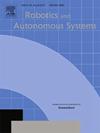ASTRA-BF:基于生物力学特征预测机器人下肢假肢表面过渡的人在环算法
IF 5.2
2区 计算机科学
Q1 AUTOMATION & CONTROL SYSTEMS
引用次数: 0
摘要
在下肢假肢和可穿戴设备领域,下肢截肢(LLA)患者在柔顺表面行走的重要性不能被夸大。人与柔顺表面之间的相互作用提出了一个独特的挑战,特别是对于那些依赖于假肢干预。确保在这些表面上运动的安全性、稳定性和流动性对于防止这一人群跌倒至关重要。这项工作深入探讨了解决这一挑战的重要性,概述了在柔顺表面行走所涉及的复杂性,并探索了旨在减轻LLA患者面临的固有困难的高级控制策略干预措施。我们特别扩展了一种个性化的模式识别(PR)和分类方法,利用运动学、动力学和表面肌电图(EMG)数据来辨别用户从刚性表面过渡到可变刚度柔顺表面的意图。本研究提出了一种基于生物力学特征的机器人下肢假肢表面转移预测算法,称为ASTRA-BF。将k近邻(kNN)方法与朴素贝叶斯分类相结合,我们的策略可以实时准确地预测四种不同表面刚度级别即将发生的转变。这种能力可以快速控制假肢或可穿戴设备的参数,促进适应不同的地形。应用ASTRA-BF后,分类结果的预测准确率高达82%,证明了在健康和临床人群中实时预测各种柔顺表面过渡的可行性和效率。所提出的框架有可能推动机器人领域向新的解决方案发展,不仅可以提高机动性,还可以显着提高那些在复杂地形上导航的人的生活质量。本文章由计算机程序翻译,如有差异,请以英文原文为准。

ASTRA-BF: A human-in-the-loop algorithm for predicting surface transitions in robotic lower limb prosthetics using biomechanical features
In the realm of lower-limb prosthetics and wearable devices, the significance of walking on compliant surfaces for individuals with lower-limb amputations (LLA) cannot be overstated. The interaction between humans and compliant surfaces presents a unique challenge, particularly for those relying on prosthetic interventions. Ensuring the safety, stability, and fluidity of movement on these surfaces is paramount for preventing falls in this population. This work delves into the critical importance of addressing this challenge, outlining the complexities involved in walking on compliant surfaces, and exploring high-level control strategy interventions aimed at mitigating the inherent difficulties faced by individuals with LLA. We specifically expand on an individualized pattern recognition (PR) and classification approach utilizing kinematic, kinetic, and surface electromyography (EMG) data to discern user intent for transitioning from rigid to compliant surfaces of variable stiffness. This work proposes an efficient Algorithm for Surface TRAnsition prediction in robotic lower limb prosthetics using Biomechanical Features, called ASTRA-BF. Integrating a k-Nearest Neighbors (kNN) methodology alongside a Naive Bayes classification, our strategy can accurately forecast impending transitions in four different levels of surface stiffness in real time. This capability enables swift parameter control of prostheses or wearable devices, facilitating adaptation to diverse terrains. Post-implementation of the ASTRA-BF, classification results attain a prediction accuracy of up to 82%, demonstrating the feasibility and efficiency of real-time prediction for transitions to various compliant surfaces in both healthy and clinical populations. The proposed framework has the potential to propel the field of robotics toward novel solutions that not only enhance mobility but also significantly improve the quality of life for those navigating the intricate terrain of compliant surfaces with prosthetic limbs.
求助全文
通过发布文献求助,成功后即可免费获取论文全文。
去求助
来源期刊

Robotics and Autonomous Systems
工程技术-机器人学
CiteScore
9.00
自引率
7.00%
发文量
164
审稿时长
4.5 months
期刊介绍:
Robotics and Autonomous Systems will carry articles describing fundamental developments in the field of robotics, with special emphasis on autonomous systems. An important goal of this journal is to extend the state of the art in both symbolic and sensory based robot control and learning in the context of autonomous systems.
Robotics and Autonomous Systems will carry articles on the theoretical, computational and experimental aspects of autonomous systems, or modules of such systems.
 求助内容:
求助内容: 应助结果提醒方式:
应助结果提醒方式:


